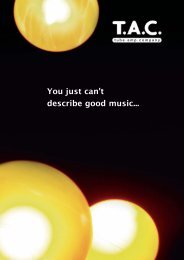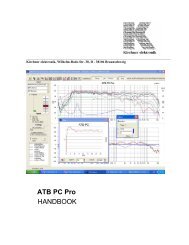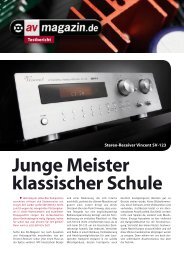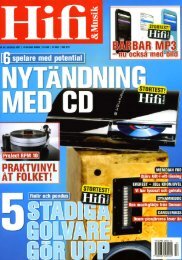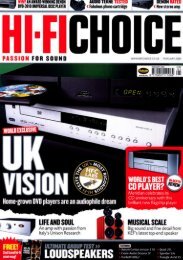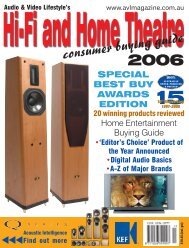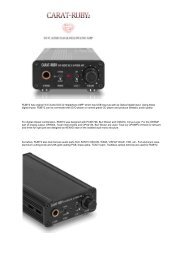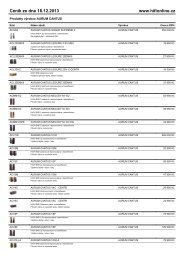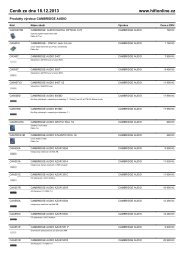Ed Momkus reaches for sonic heaven with the - Hifi on Line
Ed Momkus reaches for sonic heaven with the - Hifi on Line
Ed Momkus reaches for sonic heaven with the - Hifi on Line
Create successful ePaper yourself
Turn your PDF publications into a flip-book with our unique Google optimized e-Paper software.
Device<br />
<str<strong>on</strong>g>Ed</str<strong>on</strong>g> <str<strong>on</strong>g>Momkus</str<strong>on</strong>g> <str<strong>on</strong>g>reaches</str<strong>on</strong>g> <str<strong>on</strong>g>for</str<strong>on</strong>g> <str<strong>on</strong>g>s<strong>on</strong>ic</str<strong>on</strong>g> <str<strong>on</strong>g>heaven</str<strong>on</strong>g> <str<strong>on</strong>g>with</str<strong>on</strong>g> <str<strong>on</strong>g>the</str<strong>on</strong>g> $ 3,800<br />
Lyngdorf RP-1 RoomPerfectTM Room Correcti<strong>on</strong><br />
Specificati<strong>on</strong>s:<br />
Why We Need Room Correcti<strong>on</strong><br />
If you‟ve read about human hearing, <str<strong>on</strong>g>the</str<strong>on</strong>g> effects of your listening envir<strong>on</strong>ment <strong>on</strong> your<br />
sound, and <str<strong>on</strong>g>the</str<strong>on</strong>g> difficulties associated <str<strong>on</strong>g>with</str<strong>on</strong>g> getting realistic bass, skip <str<strong>on</strong>g>the</str<strong>on</strong>g> first two<br />
secti<strong>on</strong>s and proceed to “My Prior Attempts to Deal With My Room”. If not, read <strong>on</strong>.<br />
How does human hearing work? Most of what follows was pulled from several sources,<br />
notably http://hyperphysics.phy-astr.gsu.edu/hbase/sound, maintained by Georgia State<br />
University.<br />
The first thing to understand is that you perceive different frequencies differently at<br />
different dB levels. As <str<strong>on</strong>g>the</str<strong>on</strong>g> Georgia State University website puts it:<br />
Type: Room correcti<strong>on</strong> processor<br />
Frequency Resp<strong>on</strong>se: 20 ~ 20kHz, +/- 0.1dB<br />
S/N ratio: 113dB, analog to analog (at Neutral voicing Ref 4.4V)<br />
Dynamic range: 113dB, analog to analog (at Neutral voicing Ref<br />
4.4V)<br />
Channel separati<strong>on</strong>: 114dB<br />
Input sensitivity: 4.4V (2.2V <str<strong>on</strong>g>with</str<strong>on</strong>g> high sensitivity)<br />
Input impedance: 10kΩ balanced & single-ended<br />
DAC output impedance: 50Ω<br />
THD+N: 103dB, A-weighted, analog to analog (at Neutral voicing<br />
Ref 4.4V)<br />
Power c<strong>on</strong>sumpti<strong>on</strong>: 4W (standby mode), 23W (operate mode)<br />
Dimensi<strong>on</strong>s: 17.72 W x 13.58 D x 3.94 H (inch)<br />
Weight: 14.6lb<br />
MSRP: $3,800<br />
Manufacturer: Lyngdorf<br />
U.S. Distributor:<br />
Triad Speakers, Inc.<br />
15835 NE Camer<strong>on</strong> Blvd.<br />
Portland, OR 97230<br />
Tel. (800) 666-6316<br />
“The measured threshold of hearing curve shows that <str<strong>on</strong>g>the</str<strong>on</strong>g> sound intensity required to be heard is quite different <str<strong>on</strong>g>for</str<strong>on</strong>g> different frequencies. The standard<br />
threshold of hearing at 1000 Hz is nominally taken to be 0 dB, but <str<strong>on</strong>g>the</str<strong>on</strong>g> actual curves show <str<strong>on</strong>g>the</str<strong>on</strong>g> measured threshold at 1000 Hz to be about 4 dB. There<br />
is marked discriminati<strong>on</strong> against low frequencies so that about 60 dB is required to be heard at 30 Hz. The maximum sensitivity at about 3500 to 4000<br />
Hz is related to <str<strong>on</strong>g>the</str<strong>on</strong>g> res<strong>on</strong>ance of <str<strong>on</strong>g>the</str<strong>on</strong>g> auditory canal.”
This is illustrated by <str<strong>on</strong>g>the</str<strong>on</strong>g> following chart:<br />
A related thing to understand is that <str<strong>on</strong>g>the</str<strong>on</strong>g> differences between how we perceive <str<strong>on</strong>g>the</str<strong>on</strong>g> loudness of different frequencies can be very large.<br />
“For very soft sounds, near <str<strong>on</strong>g>the</str<strong>on</strong>g> threshold of hearing, <str<strong>on</strong>g>the</str<strong>on</strong>g> ear str<strong>on</strong>gly discriminates against low frequencies. For mid-range sounds around 60 ph<strong>on</strong>s,<br />
<str<strong>on</strong>g>the</str<strong>on</strong>g> discriminati<strong>on</strong> is not so pr<strong>on</strong>ounced and <str<strong>on</strong>g>for</str<strong>on</strong>g> very loud sounds in <str<strong>on</strong>g>the</str<strong>on</strong>g> neighborhood of 120 ph<strong>on</strong>s, <str<strong>on</strong>g>the</str<strong>on</strong>g> hearing resp<strong>on</strong>se is more nearly flat.”<br />
We audiophiles have experienced <str<strong>on</strong>g>the</str<strong>on</strong>g> problem that arises when you turn <str<strong>on</strong>g>the</str<strong>on</strong>g> volume way down: <str<strong>on</strong>g>the</str<strong>on</strong>g> bass becomes less pr<strong>on</strong>ounced. The Georgia State<br />
University website puts it as follows.<br />
“One of <str<strong>on</strong>g>the</str<strong>on</strong>g> implicati<strong>on</strong>s of this aspect of human hearing is that you will perceive a progressive loss of bass frequencies as a given sound becomes<br />
softer and softer. For example if you are listening to a recording of an orchestra and you turn <str<strong>on</strong>g>the</str<strong>on</strong>g> volume down, you will find that <str<strong>on</strong>g>the</str<strong>on</strong>g> bass instruments<br />
are less and less prominent. This is <str<strong>on</strong>g>the</str<strong>on</strong>g> purpose of <str<strong>on</strong>g>the</str<strong>on</strong>g> so-called "loudness c<strong>on</strong>tours" <strong>on</strong> audio amplifiers; <str<strong>on</strong>g>the</str<strong>on</strong>g>y allow you to boost <str<strong>on</strong>g>the</str<strong>on</strong>g> bass frequencies<br />
when you are listening at low sound levels to give you a more realistic balance of <str<strong>on</strong>g>the</str<strong>on</strong>g> high and low frequencies in <str<strong>on</strong>g>the</str<strong>on</strong>g> music.”<br />
These principles have been translated into a series of graphs that show perceived loudness of different frequencies at different decibel levels. You can<br />
see that in some cases <str<strong>on</strong>g>the</str<strong>on</strong>g> perceived “loudness gap” between low, middle and high frequencies is quite huge, while in o<str<strong>on</strong>g>the</str<strong>on</strong>g>r cases, such as when <str<strong>on</strong>g>the</str<strong>on</strong>g><br />
music as a whole gets louder, <str<strong>on</strong>g>the</str<strong>on</strong>g> differences shrink. These graphs also show <str<strong>on</strong>g>the</str<strong>on</strong>g> frequency range in which our ears functi<strong>on</strong> most efficiently. These<br />
differing percepti<strong>on</strong>s of loudness <str<strong>on</strong>g>the</str<strong>on</strong>g>n become fur<str<strong>on</strong>g>the</str<strong>on</strong>g>r complicated by reflecti<strong>on</strong>s caused by <str<strong>on</strong>g>the</str<strong>on</strong>g> room, including reflecti<strong>on</strong>s that rein<str<strong>on</strong>g>for</str<strong>on</strong>g>ce particular<br />
frequencies, or in some cases create nulls that completely cancel out a particular frequency.
As if <str<strong>on</strong>g>the</str<strong>on</strong>g> vagaries of human hearing aren‟t enough, your room will affect <str<strong>on</strong>g>the</str<strong>on</strong>g> sound of any speaker you try. This means that any set of speakers you<br />
try will sound very different in different rooms. Fur<str<strong>on</strong>g>the</str<strong>on</strong>g>rmore, depending <strong>on</strong> <str<strong>on</strong>g>the</str<strong>on</strong>g> particular speaker and its interacti<strong>on</strong> <str<strong>on</strong>g>with</str<strong>on</strong>g> <str<strong>on</strong>g>the</str<strong>on</strong>g> room, as well as <str<strong>on</strong>g>the</str<strong>on</strong>g><br />
particulars of your own hearing, a pair of speakers may sound good or poor at different volume levels. You‟ve probably experienced some systems<br />
that sound very good at low volume levels, but o<str<strong>on</strong>g>the</str<strong>on</strong>g>rs that d<strong>on</strong>‟t sound right unless you‟re playing at higher volumes. On practical effect of this is that<br />
some speakers sound better when played louder or, in some cases, will <strong>on</strong>ly sound good when played loudly. If you put such speakers in a room that<br />
muddies <str<strong>on</strong>g>the</str<strong>on</strong>g> bass or has trouble replicating <str<strong>on</strong>g>the</str<strong>on</strong>g> lowest bass notes you will invariably exacerbate <str<strong>on</strong>g>the</str<strong>on</strong>g> problem. If you could eliminate <str<strong>on</strong>g>the</str<strong>on</strong>g> room<br />
interacti<strong>on</strong> you would at least be able to retain respectable bass reproducti<strong>on</strong> at lower volume levels.
Getting The Bass “Right”<br />
Your listening envir<strong>on</strong>ment affects all frequency ranges, but anomalies in <str<strong>on</strong>g>the</str<strong>on</strong>g> bass are <str<strong>on</strong>g>the</str<strong>on</strong>g> toughest to fix. Even when listening to very high-end<br />
systems, I often had <str<strong>on</strong>g>the</str<strong>on</strong>g> feeling that <str<strong>on</strong>g>the</str<strong>on</strong>g> bass was too timid, or too flabby, or that it lacked realistic weight. Moreover, whenever I went to a live indoor<br />
c<strong>on</strong>cert I was always struck by <str<strong>on</strong>g>the</str<strong>on</strong>g> fact that <str<strong>on</strong>g>the</str<strong>on</strong>g> bass seemed louder and more powerful than what I heard coming out of so-called “high-end” systems.<br />
In fact, it bo<str<strong>on</strong>g>the</str<strong>on</strong>g>red me very much that many renowned reviewers seem to praise products that totally fail to produce realistic bass. (I d<strong>on</strong>‟t want to<br />
start a war here, but I include a few of <str<strong>on</strong>g>the</str<strong>on</strong>g> most renowned reviewers and highly praised products in this category – perhaps I‟ll put a list toge<str<strong>on</strong>g>the</str<strong>on</strong>g>r and<br />
include it in a future article.)<br />
As a result, I put years of ef<str<strong>on</strong>g>for</str<strong>on</strong>g>t into addressing bass reproducti<strong>on</strong> in my main system. I purchased a fr<strong>on</strong>t-end that went as low as possible, secured<br />
amps <str<strong>on</strong>g>with</str<strong>on</strong>g> great bass weight and installed speakers that were capable of realistically replicating 25 Hz. I supplemented this by working <str<strong>on</strong>g>with</str<strong>on</strong>g> an<br />
assortment of accessories, including cables, power c<strong>on</strong>diti<strong>on</strong>ers, isolati<strong>on</strong>, room treatments, etc. Bit by bit I inched closer to <str<strong>on</strong>g>the</str<strong>on</strong>g> goal. I minimized<br />
bass boom. I attacked slow and bloated bass. I added more bass weight. The problem was, I often improved <strong>on</strong>e aspect of <str<strong>on</strong>g>the</str<strong>on</strong>g> bass, but affected a<br />
different aspect. Finally, in <str<strong>on</strong>g>the</str<strong>on</strong>g> middle of 2007 I achieved what I felt was <str<strong>on</strong>g>the</str<strong>on</strong>g> best bass I‟d heard in any of my own pers<strong>on</strong>al systems, and in most<br />
cases better than <str<strong>on</strong>g>the</str<strong>on</strong>g> bass I‟d heard in o<str<strong>on</strong>g>the</str<strong>on</strong>g>r high-end systems. However, it still seemed to occasi<strong>on</strong>ally lack <str<strong>on</strong>g>the</str<strong>on</strong>g> slam that I heard in live c<strong>on</strong>certs at top<br />
notch venues, and I began to think that I would never get it completely right in my current room.<br />
My Prior Attempts to Deal With my Room<br />
As you can see, I have been acutely aware of <str<strong>on</strong>g>the</str<strong>on</strong>g> effect that <str<strong>on</strong>g>the</str<strong>on</strong>g> room has <strong>on</strong> an audio system, and I‟ve taken very extensive steps to address <str<strong>on</strong>g>the</str<strong>on</strong>g><br />
problem. My listening room sports three 20” x 78” ASC Tower Traps, two 20” x 48” ASC Tower Traps, <strong>on</strong>e 16” x 48” ASC Tube Trap, two 16” x<br />
60” Quarter Round traps, twelve 8” x 48” ASC Sound Panels and 4 Corner Busters. I‟ve been to very high-end listening rooms, but I‟ve <strong>on</strong>ly<br />
encountered 2 or 3 that have paid as much attenti<strong>on</strong> to room treatments as I have. C<strong>on</strong>sequently, I assumed that digital room correcti<strong>on</strong> would have<br />
some, but not much, effect <strong>on</strong> my listening envir<strong>on</strong>ment. Fur<str<strong>on</strong>g>the</str<strong>on</strong>g>rmore, I have always felt that I should keep <str<strong>on</strong>g>the</str<strong>on</strong>g> signal as “pure” as possible, and that<br />
introducing A-to-D and D-to-A c<strong>on</strong>versi<strong>on</strong> is audiophile blasphemy. However, a true audio addict eventually has to try everything, so I asked<br />
C<strong>on</strong>stantine Soo if I could review a digital room correcti<strong>on</strong> system <str<strong>on</strong>g>for</str<strong>on</strong>g> Dagogo. He told me to have at it, so I started to look <str<strong>on</strong>g>for</str<strong>on</strong>g> a model that would<br />
work well in my system. As it turned out, it wasn‟t as easy as I thought it would be.<br />
The first problem I encountered related to my Esoteric P-70/D-70 fr<strong>on</strong>t-end. The Esoteric sounds <str<strong>on</strong>g>the</str<strong>on</strong>g> best in its dual AES mode. In <str<strong>on</strong>g>the</str<strong>on</strong>g> dual AES<br />
mode, <str<strong>on</strong>g>the</str<strong>on</strong>g> transport splits <str<strong>on</strong>g>the</str<strong>on</strong>g> digital signal into left and right and transmits <str<strong>on</strong>g>the</str<strong>on</strong>g> signal this way to <str<strong>on</strong>g>the</str<strong>on</strong>g> DAC, which accepts <str<strong>on</strong>g>the</str<strong>on</strong>g> left and right digital<br />
signals. The dual AES mode ONLY operates <str<strong>on</strong>g>with</str<strong>on</strong>g> AES/EBU digital cables – no RCA cables need apply. This means that any black box that would go<br />
between my transport and DAC must accept dual AES/EBU cables and also output a dual digital signal via dual AES/EBU cables. Seen any device<br />
that meets those criteria? Nope! That meant that whatever device I used would have to be inserted in <str<strong>on</strong>g>the</str<strong>on</strong>g> analog path of my system.<br />
The sec<strong>on</strong>d thing I encountered was <str<strong>on</strong>g>the</str<strong>on</strong>g> dearth of room correcti<strong>on</strong> devices which employ balanced analog inputs and outputs. Not <strong>on</strong>ly does <str<strong>on</strong>g>the</str<strong>on</strong>g> P-
70/D-70 combo sound best <str<strong>on</strong>g>with</str<strong>on</strong>g> AES/EBU digital cables running between <str<strong>on</strong>g>the</str<strong>on</strong>g> transport and DAC, but it also sounds better via its balanced analog<br />
outputs, and I run my whole system balanced. Few digital room correcti<strong>on</strong> systems have balanced analog inputs and outputs.<br />
After all of <str<strong>on</strong>g>the</str<strong>on</strong>g>se limitati<strong>on</strong>s were taken into account, <str<strong>on</strong>g>the</str<strong>on</strong>g> <strong>on</strong>ly room correcti<strong>on</strong> system that would work <str<strong>on</strong>g>for</str<strong>on</strong>g> me was <str<strong>on</strong>g>the</str<strong>on</strong>g> Lyngdorf RP-1. I was initially<br />
worried that I wouldn‟t be able to compare <str<strong>on</strong>g>the</str<strong>on</strong>g> Lyngdorf to o<str<strong>on</strong>g>the</str<strong>on</strong>g>r room correcti<strong>on</strong> devices. I will tell you right now that I had no reas<strong>on</strong> to worry. I<br />
d<strong>on</strong>‟t know if o<str<strong>on</strong>g>the</str<strong>on</strong>g>r room correcti<strong>on</strong> devices are better, but <str<strong>on</strong>g>the</str<strong>on</strong>g> Lyngdorf RP-1 wrought great improvement in my system.<br />
Who Sells Lyngdorf ?<br />
Or maybe even more importantly, how do I get a Lyngdorf? I had no idea. Lyngdorf distributes its products through a limited number of dealers, but<br />
it just so happens that <strong>on</strong>e of <str<strong>on</strong>g>the</str<strong>on</strong>g>m is Ken Walker of Sound Design Systems, located in Winfield, IL, which is a western suburb of Chicago. I was<br />
happy that <str<strong>on</strong>g>the</str<strong>on</strong>g>re was a dealer in <str<strong>on</strong>g>the</str<strong>on</strong>g> Chicago area, but I was apprehensive after I looked at his website. I worried that he would be a home <str<strong>on</strong>g>the</str<strong>on</strong>g>ater guy<br />
who would not appreciate my two-channel obsessi<strong>on</strong>. I should never have worried. Ken turned out to be an audio enthusiast who loves great twochannel<br />
music and fine tequila. He was incredibly helpful by securing a demo RP-1 and pers<strong>on</strong>ally coming to my house to install and program it.<br />
I want to make clear that I never told Ken that I‟m a reviewer or that I write <str<strong>on</strong>g>for</str<strong>on</strong>g> Dagogo. I simply told him that I‟m interested in <str<strong>on</strong>g>the</str<strong>on</strong>g> RP-1 and would<br />
like a demo, and he showed up <strong>on</strong> a Saturday morning to install it.<br />
There is also <str<strong>on</strong>g>the</str<strong>on</strong>g> questi<strong>on</strong> of who is Lyngdorf? It‟s a company named after its main man and chief designer, Peter Lyngdorf. We are not talking about<br />
a novice designer. I w<strong>on</strong>‟t go through Peter Lyngdorf‟s entire audio history, but I will menti<strong>on</strong> <str<strong>on</strong>g>the</str<strong>on</strong>g> name Tact Audio and <str<strong>on</strong>g>the</str<strong>on</strong>g> Millennium digital amp.<br />
Yep – that Peter Lyngdorf.
What Are We Doing Here ?<br />
Legitimate philosophical questi<strong>on</strong>, but that‟s not what I mean. The questi<strong>on</strong> is, what does digital<br />
correcti<strong>on</strong> actually do? As it turns out, different correcti<strong>on</strong> devices have different goals. Some are<br />
massively ambitious devices that allow you to tri-amp your speakers and adjust <str<strong>on</strong>g>the</str<strong>on</strong>g> bass, midrange<br />
and treble, as well as adjust <str<strong>on</strong>g>for</str<strong>on</strong>g> <str<strong>on</strong>g>the</str<strong>on</strong>g> effects of <str<strong>on</strong>g>the</str<strong>on</strong>g> room. O<str<strong>on</strong>g>the</str<strong>on</strong>g>rs are less ambitious and make limited<br />
adjustments to <str<strong>on</strong>g>the</str<strong>on</strong>g> speakers, or try to make adjustments in <str<strong>on</strong>g>the</str<strong>on</strong>g> time domain. I encourage you to go<br />
to <str<strong>on</strong>g>the</str<strong>on</strong>g> Lyngdorf website <str<strong>on</strong>g>for</str<strong>on</strong>g> a detailed descripti<strong>on</strong> of what Peter Lyngdorf is trying to accomplish<br />
<str<strong>on</strong>g>with</str<strong>on</strong>g> <str<strong>on</strong>g>the</str<strong>on</strong>g> RP-1, since I will <strong>on</strong>ly summarize it here.<br />
As I understand it, Peter Lyngdorf starts <str<strong>on</strong>g>with</str<strong>on</strong>g> <str<strong>on</strong>g>the</str<strong>on</strong>g> assumpti<strong>on</strong> that you basically like your speakers<br />
and do not want to mess <str<strong>on</strong>g>with</str<strong>on</strong>g> <str<strong>on</strong>g>the</str<strong>on</strong>g>ir fundamental sound. Based <strong>on</strong> this assumpti<strong>on</strong>, <str<strong>on</strong>g>the</str<strong>on</strong>g> RP-1 does<br />
not try to correct <str<strong>on</strong>g>for</str<strong>on</strong>g> speaker per<str<strong>on</strong>g>for</str<strong>on</strong>g>mance. Instead, <str<strong>on</strong>g>the</str<strong>on</strong>g> c<strong>on</strong>cept is to allow <str<strong>on</strong>g>the</str<strong>on</strong>g> speaker to sound its<br />
best by <strong>on</strong>ly adjusting <str<strong>on</strong>g>for</str<strong>on</strong>g> <str<strong>on</strong>g>the</str<strong>on</strong>g> pernicious effects of <str<strong>on</strong>g>the</str<strong>on</strong>g> room. How does <str<strong>on</strong>g>the</str<strong>on</strong>g> RP-1 do this? No idea.<br />
For all I know, Lyngdorf could be applying secrets learned from <str<strong>on</strong>g>the</str<strong>on</strong>g> Krill who reside <strong>on</strong> <str<strong>on</strong>g>the</str<strong>on</strong>g> planet<br />
Zartran. I know something about <str<strong>on</strong>g>the</str<strong>on</strong>g> electr<strong>on</strong>ics and design <str<strong>on</strong>g>the</str<strong>on</strong>g>ories that apply to preamps, amps<br />
and speakers. I know less about <str<strong>on</strong>g>the</str<strong>on</strong>g> technology behind transports and DACs, but enough to sound<br />
intelligent (I talk a good talk). However, I know nothing about sophisticated digital correcti<strong>on</strong><br />
devices, so I am acting here purely as a subjective reviewer.<br />
Installati<strong>on</strong><br />
Installing <str<strong>on</strong>g>the</str<strong>on</strong>g> RP-1 was simple. I know, how can it not be simple when some<strong>on</strong>e else installs it <str<strong>on</strong>g>for</str<strong>on</strong>g> me? Well, I‟m an obsessive guy, so even though<br />
Ken Walker installed <str<strong>on</strong>g>the</str<strong>on</strong>g> system <str<strong>on</strong>g>for</str<strong>on</strong>g> me originally, I later disassembled and reprogrammed <str<strong>on</strong>g>the</str<strong>on</strong>g> system using different speakers, such as <str<strong>on</strong>g>the</str<strong>on</strong>g> $28,000<br />
Eventus Audio Lysi<str<strong>on</strong>g>the</str<strong>on</strong>g>as (review to follow). In my case, I inserted it between by preamp and amp. You can also insert <str<strong>on</strong>g>the</str<strong>on</strong>g> RP-1 into your system via<br />
a tape loop, or you can put it between your source and your preamp, although this last method is not desirable if you have multiple sources.<br />
After c<strong>on</strong>necting <str<strong>on</strong>g>the</str<strong>on</strong>g> RP-1, you need to set <str<strong>on</strong>g>the</str<strong>on</strong>g> measurement volume level. Setting <str<strong>on</strong>g>the</str<strong>on</strong>g> measurement volume level is important, since <str<strong>on</strong>g>the</str<strong>on</strong>g> microph<strong>on</strong>e<br />
must be able to pick up <str<strong>on</strong>g>the</str<strong>on</strong>g> test t<strong>on</strong>es, but <str<strong>on</strong>g>the</str<strong>on</strong>g> volume shouldn‟t be so loud as to risk clipping. This is very easy, as <str<strong>on</strong>g>the</str<strong>on</strong>g> RP-1 actually tells you whe<str<strong>on</strong>g>the</str<strong>on</strong>g>r<br />
you should increase or lower <str<strong>on</strong>g>the</str<strong>on</strong>g> volume.<br />
The next step is to measure <str<strong>on</strong>g>the</str<strong>on</strong>g> distance from <str<strong>on</strong>g>the</str<strong>on</strong>g> speakers to your ears when you are sitting in your principal listening positi<strong>on</strong>. The distance<br />
in<str<strong>on</strong>g>for</str<strong>on</strong>g>mati<strong>on</strong> is <str<strong>on</strong>g>the</str<strong>on</strong>g>n input into <str<strong>on</strong>g>the</str<strong>on</strong>g> RP-1.<br />
Once <str<strong>on</strong>g>the</str<strong>on</strong>g>se initial steps have been taken (about 10 minutes), you c<strong>on</strong>nect a supplied microph<strong>on</strong>e (microph<strong>on</strong>e stand and l<strong>on</strong>g cord included) and<br />
positi<strong>on</strong> it at your principal (called “focus”) listening positi<strong>on</strong>. You <str<strong>on</strong>g>the</str<strong>on</strong>g>n run a series of test t<strong>on</strong>es, all of which are automatically initiated and
measured by <str<strong>on</strong>g>the</str<strong>on</strong>g> RP-1 from your left and right speakers. Once this sequence is completed, <str<strong>on</strong>g>the</str<strong>on</strong>g> RP-1 tells you <str<strong>on</strong>g>the</str<strong>on</strong>g> percentage of “Room Knowledge” it<br />
acquired from <str<strong>on</strong>g>the</str<strong>on</strong>g> test t<strong>on</strong>es and invites you to measure a sec<strong>on</strong>d positi<strong>on</strong> in <str<strong>on</strong>g>the</str<strong>on</strong>g> room. You <str<strong>on</strong>g>the</str<strong>on</strong>g>n move <str<strong>on</strong>g>the</str<strong>on</strong>g> microph<strong>on</strong>e at least 1 meter to <str<strong>on</strong>g>the</str<strong>on</strong>g> left or<br />
right and repeat <str<strong>on</strong>g>the</str<strong>on</strong>g> test t<strong>on</strong>es. This process is repeated at different positi<strong>on</strong>s in <str<strong>on</strong>g>the</str<strong>on</strong>g> room until you maximize <str<strong>on</strong>g>the</str<strong>on</strong>g> RP-1‟s “Room Knowledge”. In my<br />
case, I stopped at 99% “Room Knowledge”. You‟re d<strong>on</strong>e. The entire process took me 24 minutes; it might have taken me 35 minutes if I had not seen<br />
Ken Walker do it <str<strong>on</strong>g>the</str<strong>on</strong>g> first time.<br />
Keep in mind that this process needs to be repeated if you move or change speakers, or do something else significant to your listening room, but <strong>on</strong>ce<br />
you‟ve d<strong>on</strong>e it <str<strong>on</strong>g>the</str<strong>on</strong>g> first time you will breeze right through it. The RP-1 also allows you to display <str<strong>on</strong>g>the</str<strong>on</strong>g> amount of correcti<strong>on</strong> being applied to correct <str<strong>on</strong>g>for</str<strong>on</strong>g><br />
<str<strong>on</strong>g>the</str<strong>on</strong>g> anomalies of your room. In my case, <str<strong>on</strong>g>the</str<strong>on</strong>g> correcti<strong>on</strong> level was <strong>on</strong>ly 10%, which I understand is <strong>on</strong> <str<strong>on</strong>g>the</str<strong>on</strong>g> low end of expected correcti<strong>on</strong>. This was<br />
c<strong>on</strong>sistent <str<strong>on</strong>g>with</str<strong>on</strong>g> my expectati<strong>on</strong>s, given <str<strong>on</strong>g>the</str<strong>on</strong>g> extensive room treatments I‟ve installed.<br />
This is not <str<strong>on</strong>g>the</str<strong>on</strong>g> end of <str<strong>on</strong>g>the</str<strong>on</strong>g> Lyngdorf RP-1‟s capabilities, which include <str<strong>on</strong>g>the</str<strong>on</strong>g> ability to integrate dual subs, which can be a great bo<strong>on</strong> in satellite systems.<br />
However, I did not bo<str<strong>on</strong>g>the</str<strong>on</strong>g>r doing this since <str<strong>on</strong>g>the</str<strong>on</strong>g> RP-1 trans<str<strong>on</strong>g>for</str<strong>on</strong>g>med my full-range speakers into really full-range speakers. If you have a satellite/sub<br />
system, you should seriously c<strong>on</strong>sider <str<strong>on</strong>g>the</str<strong>on</strong>g> Lyngdorf (or something like it). I suspect that you will find your system trans<str<strong>on</strong>g>for</str<strong>on</strong>g>med. You can find this info<br />
<strong>on</strong> Lyngdorf‟s website (http://www.lyngdorf.com) in <str<strong>on</strong>g>the</str<strong>on</strong>g> RP-1 owner‟s manual that is posted <strong>on</strong> <str<strong>on</strong>g>the</str<strong>on</strong>g> site.<br />
Listening & Comparing<br />
Despite <str<strong>on</strong>g>the</str<strong>on</strong>g> fact that <str<strong>on</strong>g>the</str<strong>on</strong>g> correcti<strong>on</strong> percentage was <strong>on</strong>ly at 10%, <str<strong>on</strong>g>the</str<strong>on</strong>g> improvement in <str<strong>on</strong>g>the</str<strong>on</strong>g> sound was very large. Everything sounded better.
First, <str<strong>on</strong>g>the</str<strong>on</strong>g> lowest bass notes were now clearly audible, whereas <str<strong>on</strong>g>the</str<strong>on</strong>g>y were previously a muffled rumble. Sec<strong>on</strong>d, <str<strong>on</strong>g>the</str<strong>on</strong>g> impact of <str<strong>on</strong>g>the</str<strong>on</strong>g> bass was<br />
dramatically enhanced. Kick drums really kicked <str<strong>on</strong>g>with</str<strong>on</strong>g> a <str<strong>on</strong>g>for</str<strong>on</strong>g>ce I had not previously experienced. Third, and this may relate to <str<strong>on</strong>g>the</str<strong>on</strong>g> sec<strong>on</strong>d, <str<strong>on</strong>g>the</str<strong>on</strong>g> timing of<br />
everything improved, <str<strong>on</strong>g>with</str<strong>on</strong>g> more coherence to <str<strong>on</strong>g>the</str<strong>on</strong>g> music. Fourth, gaps in some lower midrange and upper bass frequencies got filled in, creating more<br />
body and warmth to <str<strong>on</strong>g>the</str<strong>on</strong>g> presentati<strong>on</strong>. Fifth, <str<strong>on</strong>g>the</str<strong>on</strong>g> relati<strong>on</strong>ship between <str<strong>on</strong>g>the</str<strong>on</strong>g> lowest and highest notes became more natural and realistic-sounding – more<br />
like <str<strong>on</strong>g>the</str<strong>on</strong>g>y are heard in a live c<strong>on</strong>cert. I did not need to turn <str<strong>on</strong>g>the</str<strong>on</strong>g> volume up to get <str<strong>on</strong>g>the</str<strong>on</strong>g> bass intro to sound lifelike, <strong>on</strong>ly to be <str<strong>on</strong>g>for</str<strong>on</strong>g>ced to turn <str<strong>on</strong>g>the</str<strong>on</strong>g> volume<br />
down when <str<strong>on</strong>g>the</str<strong>on</strong>g> vocalist began singing. Here are three examples.<br />
The lowest bass frequencies <strong>on</strong> <str<strong>on</strong>g>the</str<strong>on</strong>g> Mobile Fidelity Sound Lab Ultradisc of Yes‟ Fragile (UDCD 766) were felt be<str<strong>on</strong>g>for</str<strong>on</strong>g>e <str<strong>on</strong>g>the</str<strong>on</strong>g> Lyngdorf, but were not<br />
distinct notes in my system. O<str<strong>on</strong>g>the</str<strong>on</strong>g>r listeners would rave about <str<strong>on</strong>g>the</str<strong>on</strong>g> bass, but I knew that <str<strong>on</strong>g>the</str<strong>on</strong>g>re were some notes that I was not really hearing. The<br />
instant <str<strong>on</strong>g>the</str<strong>on</strong>g> RP-1 was engaged, those notes became clear t<strong>on</strong>es, not just a rumble, and <str<strong>on</strong>g>the</str<strong>on</strong>g> organ and lead guitar snapped into much better focus. I<br />
involuntarily pumped my fist and blurted “Yesssss!” (Really)<br />
The Supreme Beings of Leisure‟s self titled CD (PALMCD 2006-2) c<strong>on</strong>tains a tune entitled „Strangelove Addicti<strong>on</strong>‟. This piece has syn<str<strong>on</strong>g>the</str<strong>on</strong>g>sizers,<br />
bass and a variety of percussi<strong>on</strong> and o<str<strong>on</strong>g>the</str<strong>on</strong>g>r instruments that collapse into a big mess if <str<strong>on</strong>g>the</str<strong>on</strong>g> system cannot sort out all of <str<strong>on</strong>g>the</str<strong>on</strong>g> rhythms and sustain <str<strong>on</strong>g>the</str<strong>on</strong>g><br />
music‟s drive. I though that my system did a pretty good job of it until I heard it <str<strong>on</strong>g>with</str<strong>on</strong>g> <str<strong>on</strong>g>the</str<strong>on</strong>g> RP-1 engaged. For <str<strong>on</strong>g>the</str<strong>on</strong>g> first time, everything fell into place. I<br />
heard notes I had not heard be<str<strong>on</strong>g>for</str<strong>on</strong>g>e.<br />
The first track <strong>on</strong> World Party‟s Private Revoluti<strong>on</strong> (Chrysalis F2 21552) is not a very good recording, and it c<strong>on</strong>tains what sounded like <str<strong>on</strong>g>the</str<strong>on</strong>g> sounds<br />
of a compressed organ that swirl around <str<strong>on</strong>g>the</str<strong>on</strong>g> center of <str<strong>on</strong>g>the</str<strong>on</strong>g> soundstage. Mildly interesting, but certainly not memorable. However, <str<strong>on</strong>g>with</str<strong>on</strong>g> <str<strong>on</strong>g>the</str<strong>on</strong>g> RP-1<br />
engaged <str<strong>on</strong>g>the</str<strong>on</strong>g>se sounds clarified and expanded in both width and depth and, <str<strong>on</strong>g>for</str<strong>on</strong>g> <str<strong>on</strong>g>the</str<strong>on</strong>g> first time, were clearly an organ. It was as though I had just<br />
received a superbly remastered replacement to an old, poorly mastered CD.<br />
These experiences were repeated <str<strong>on</strong>g>with</str<strong>on</strong>g> every recording I played. But that‟s not all. The Lyngdorf RP-1 allows you to engage room correcti<strong>on</strong> in<br />
FOCUS mode, GLOBAL mode or BYPASS mode. FOCUS mode is <str<strong>on</strong>g>the</str<strong>on</strong>g> best correcti<strong>on</strong> algorithm <str<strong>on</strong>g>for</str<strong>on</strong>g> you main listening positi<strong>on</strong>. GLOBAL mode<br />
lessens <str<strong>on</strong>g>the</str<strong>on</strong>g> effect at you main listening positi<strong>on</strong>, but enhances <str<strong>on</strong>g>the</str<strong>on</strong>g> sound throughout <str<strong>on</strong>g>the</str<strong>on</strong>g> room, which is perfect if you have several people seated in<br />
different locati<strong>on</strong>s. BYPASS allows you to engage and disengage <str<strong>on</strong>g>the</str<strong>on</strong>g> RoomPerfectTM digital room correcti<strong>on</strong> algorithms and compare processed to<br />
unprocessed sound. This can be d<strong>on</strong>e from <str<strong>on</strong>g>the</str<strong>on</strong>g> remote c<strong>on</strong>trol. You can compare <str<strong>on</strong>g>the</str<strong>on</strong>g> processed and unprocessed sound in a direct A-B fashi<strong>on</strong> (make<br />
sure you equalize <str<strong>on</strong>g>the</str<strong>on</strong>g> volume). Doing so is instructive. The improvement is immediate and unmistakable. You will w<strong>on</strong>der why your mo<str<strong>on</strong>g>the</str<strong>on</strong>g>r never<br />
told you about this when you were growing up.<br />
In additi<strong>on</strong>, <str<strong>on</strong>g>the</str<strong>on</strong>g> Lyngdorf RP-1 allows you to “voice” <str<strong>on</strong>g>the</str<strong>on</strong>g> resulting sound. Voicing applies an EQ filter that makes mild adjustments designed to<br />
ei<str<strong>on</strong>g>the</str<strong>on</strong>g>r: (a) compensate <str<strong>on</strong>g>for</str<strong>on</strong>g> recordings that sound too bright or dark or (b) adjust <str<strong>on</strong>g>the</str<strong>on</strong>g> sound <str<strong>on</strong>g>for</str<strong>on</strong>g> your own pers<strong>on</strong>al preferences. The Voicing settings are<br />
called Neutral, Music 1, Music 2, Relaxed, Open, Open Air, and Soft. These settings corresp<strong>on</strong>d to <str<strong>on</strong>g>the</str<strong>on</strong>g> frequency curves displayed below (from<br />
Owner's Manual).
I preferred Neutral about 95% of <str<strong>on</strong>g>the</str<strong>on</strong>g> time, but some visitors liked <str<strong>on</strong>g>the</str<strong>on</strong>g> Music 1 and Soft filters slightly better. They all said that <str<strong>on</strong>g>the</str<strong>on</strong>g> improvement that<br />
came from engaging <str<strong>on</strong>g>the</str<strong>on</strong>g> RP-1‟s processing far overshadowed <str<strong>on</strong>g>the</str<strong>on</strong>g> additi<strong>on</strong>al adjustments you could make to suit your own pers<strong>on</strong>al preference.
C<strong>on</strong>clusi<strong>on</strong><br />
The Lyngdorf RP-1 has changed my entire percepti<strong>on</strong> of equalizati<strong>on</strong>. I know – this is not <str<strong>on</strong>g>the</str<strong>on</strong>g> equalizer of <str<strong>on</strong>g>the</str<strong>on</strong>g> 1970‟s, but I have always c<strong>on</strong>sidered it<br />
a sacrilege to mess <str<strong>on</strong>g>with</str<strong>on</strong>g> simple and pure two-channel sound. To my ears, <str<strong>on</strong>g>the</str<strong>on</strong>g> Lyngdorf RP-1‟s c<strong>on</strong>tributi<strong>on</strong> ranks am<strong>on</strong>g <str<strong>on</strong>g>the</str<strong>on</strong>g> top improvements I‟ve<br />
made at any time since I took up this hobby, and it‟s clearly <str<strong>on</strong>g>the</str<strong>on</strong>g> largest improvement since I‟ve had my reference system of Esoteric P-70/D-70,<br />
Electrocompaniet Nemo M<strong>on</strong>oblocks and B&W Nautilus 800Ds.<br />
When you c<strong>on</strong>sider that I have over $5,000 worth of room treatments and that I could have avoided buying <str<strong>on</strong>g>the</str<strong>on</strong>g>m, and can now actually c<strong>on</strong>sider<br />
removing <str<strong>on</strong>g>the</str<strong>on</strong>g>m, <str<strong>on</strong>g>the</str<strong>on</strong>g> $3,800 cost of <str<strong>on</strong>g>the</str<strong>on</strong>g> RP-1 is a bargain. In fact, I think it‟s fair to say that <str<strong>on</strong>g>the</str<strong>on</strong>g> Lyngdorf RP-1 is <str<strong>on</strong>g>the</str<strong>on</strong>g> most cost-effective piece of audio<br />
hardware that I‟ve pers<strong>on</strong>ally tried. This does not even take into account that fact that an audiophile can address <str<strong>on</strong>g>the</str<strong>on</strong>g> Spousal Approval Factor by<br />
moving speakers closer into walls and corners. The Lyngdorf allows much more latitude in speaker placement since it addresses <str<strong>on</strong>g>the</str<strong>on</strong>g> speakers‟<br />
interacti<strong>on</strong> <str<strong>on</strong>g>with</str<strong>on</strong>g> <str<strong>on</strong>g>the</str<strong>on</strong>g> room and will correct <str<strong>on</strong>g>for</str<strong>on</strong>g> less-than-ideal positi<strong>on</strong>ing.<br />
The <strong>on</strong>ly thing that <str<strong>on</strong>g>the</str<strong>on</strong>g> Lyngdorf DP-1 might have c<strong>on</strong>sidered adding was <str<strong>on</strong>g>the</str<strong>on</strong>g> ability to program custom voicing, which would allow a user to, in<br />
additi<strong>on</strong> to <str<strong>on</strong>g>the</str<strong>on</strong>g> preprogrammed voicing filters, create a filter that perfectly matches his pers<strong>on</strong>al taste.<br />
For example, such a feature is built into <str<strong>on</strong>g>the</str<strong>on</strong>g> Copland DRC205, which permits a user to use <str<strong>on</strong>g>the</str<strong>on</strong>g> programmed filters or to c<strong>on</strong>nect <str<strong>on</strong>g>the</str<strong>on</strong>g> unit to a computer<br />
and create a custom filter. However, I really like <str<strong>on</strong>g>the</str<strong>on</strong>g> RP-1‟s Neutral voice setting, which happens to exactly match what I pers<strong>on</strong>ally think is <str<strong>on</strong>g>the</str<strong>on</strong>g> most<br />
realistic voicing that I can get from my B&W 800Ds. (Not to menti<strong>on</strong> <str<strong>on</strong>g>the</str<strong>on</strong>g> fact that <str<strong>on</strong>g>the</str<strong>on</strong>g> Copland does not provide any balanced inputs or outputs.)<br />
Thus, I feel absolutely no need to program any fur<str<strong>on</strong>g>the</str<strong>on</strong>g>r custom filters, especially in view of <str<strong>on</strong>g>the</str<strong>on</strong>g> fact that <str<strong>on</strong>g>the</str<strong>on</strong>g> filter choices provided by Lyngdorf<br />
address most problems created by poor recordings.<br />
Though <str<strong>on</strong>g>the</str<strong>on</strong>g> RP-1 is an add-<strong>on</strong> “black box”, you can also purchase a Lyngdorf DPA-1 digital preamp that incorporates RoomPerfectTM room<br />
correcti<strong>on</strong>. I kind of wish I had heard of <str<strong>on</strong>g>the</str<strong>on</strong>g> Lyngdorf DPA-1 be<str<strong>on</strong>g>for</str<strong>on</strong>g>e I purchased my current preamp. I love my MBL 5011 preamp, but adding it did<br />
not make anywhere near <str<strong>on</strong>g>the</str<strong>on</strong>g> impact of adding <str<strong>on</strong>g>the</str<strong>on</strong>g> RP-1. Assuming that <str<strong>on</strong>g>the</str<strong>on</strong>g> quality of <str<strong>on</strong>g>the</str<strong>on</strong>g> o<str<strong>on</strong>g>the</str<strong>on</strong>g>r digital features was up to par, I might have saved a t<strong>on</strong><br />
of m<strong>on</strong>ey and gotten a preamp that incorporated room correcti<strong>on</strong>.<br />
As final proof of how impressed I was <str<strong>on</strong>g>with</str<strong>on</strong>g> <str<strong>on</strong>g>the</str<strong>on</strong>g> w<strong>on</strong>derful effect that this product had in my system, I bought <strong>on</strong>e. Not <str<strong>on</strong>g>the</str<strong>on</strong>g> review sample whose price<br />
I might have negotiated to save Lyngdorf <str<strong>on</strong>g>the</str<strong>on</strong>g> shipping costs, but a new full-price RP-1, including Illinois taxes. Now that‟s an endorsement! (It is so<br />
difficult to c<strong>on</strong>vince my fellow Dagogoans to always purchase products at industry accommodati<strong>on</strong> prices. Sigh. –<str<strong>on</strong>g>Ed</str<strong>on</strong>g>.)
Comment From Lyngdorf :<br />
Excellent review - which I feel captures <str<strong>on</strong>g>the</str<strong>on</strong>g> essence of RoomPerfect. <str<strong>on</strong>g>Ed</str<strong>on</strong>g>‟s review accurately captures Lyngdorf‟s room correcti<strong>on</strong> philosophy in <str<strong>on</strong>g>the</str<strong>on</strong>g><br />
paragraph titled, “What Are We Doing Here” as well as <str<strong>on</strong>g>the</str<strong>on</strong>g> improvements in sound it provides. Bravo!<br />
It might be helpful to note that a primary differentiator of <str<strong>on</strong>g>the</str<strong>on</strong>g> Lyngdorf RP-1 from o<str<strong>on</strong>g>the</str<strong>on</strong>g>r room correcti<strong>on</strong> systems is that it maps <str<strong>on</strong>g>the</str<strong>on</strong>g> entire listening<br />
space in 3 dimensi<strong>on</strong>s.<br />
This is illustrated by <str<strong>on</strong>g>the</str<strong>on</strong>g> fact that after you take <str<strong>on</strong>g>the</str<strong>on</strong>g> Focus Positi<strong>on</strong> measurement at <str<strong>on</strong>g>the</str<strong>on</strong>g> listening positi<strong>on</strong>, you are supposed to take subsequent Room<br />
Measurements <str<strong>on</strong>g>with</str<strong>on</strong>g> <str<strong>on</strong>g>the</str<strong>on</strong>g> microph<strong>on</strong>e randomly positi<strong>on</strong>ed and oriented in 3-dimensi<strong>on</strong>al space. This means up near <str<strong>on</strong>g>the</str<strong>on</strong>g> ceiling, down near <str<strong>on</strong>g>the</str<strong>on</strong>g> floor,<br />
near walls, in open and adjoining areas, etc. O<str<strong>on</strong>g>the</str<strong>on</strong>g>r systems look <str<strong>on</strong>g>for</str<strong>on</strong>g> mic to be located solely at <str<strong>on</strong>g>the</str<strong>on</strong>g> listening positi<strong>on</strong> (1-D) or at multiple listening<br />
positi<strong>on</strong>s (i.e. in 2-D plane).<br />
On background in<str<strong>on</strong>g>for</str<strong>on</strong>g>mati<strong>on</strong> described in <str<strong>on</strong>g>the</str<strong>on</strong>g> paragraph titled, “Who Sells Lyngdorf” (last paragraph), while Peter is definitely <str<strong>on</strong>g>the</str<strong>on</strong>g> Main Man at<br />
Lyngdorf Audio (he is <str<strong>on</strong>g>the</str<strong>on</strong>g> owner and inspirati<strong>on</strong> of <str<strong>on</strong>g>the</str<strong>on</strong>g> company), he is not <str<strong>on</strong>g>the</str<strong>on</strong>g> chief designer. That role is held by Lyngdorf Audio‟s CTO Jan<br />
Abildgaard Pedersen, who happens to be <strong>on</strong>e of <str<strong>on</strong>g>the</str<strong>on</strong>g> world‟s <str<strong>on</strong>g>for</str<strong>on</strong>g>emost acousticians as well as a brilliant engineer and programmer. In fact, Peter has<br />
assembled <strong>on</strong>e of if not <str<strong>on</strong>g>the</str<strong>on</strong>g> most remarkable engineering staffs in <str<strong>on</strong>g>the</str<strong>on</strong>g> history of high end audio. Over 30 of <str<strong>on</strong>g>the</str<strong>on</strong>g> 50+ employees are engineers,<br />
including <str<strong>on</strong>g>the</str<strong>on</strong>g> CEO. Talk about engineering driven! (BTW, Peter also owns Dali Speakers.)<br />
I was please to see you menti<strong>on</strong> <str<strong>on</strong>g>the</str<strong>on</strong>g> real world applicati<strong>on</strong>s of RoomPerfect where speakers can be made to sound <str<strong>on</strong>g>the</str<strong>on</strong>g>ir best in <str<strong>on</strong>g>the</str<strong>on</strong>g> locati<strong>on</strong>s where<br />
most of us are <str<strong>on</strong>g>for</str<strong>on</strong>g>ced to listen to <str<strong>on</strong>g>the</str<strong>on</strong>g>m – typically much closer to <str<strong>on</strong>g>the</str<strong>on</strong>g> fr<strong>on</strong>t wall than ideal <str<strong>on</strong>g>for</str<strong>on</strong>g> best frequency resp<strong>on</strong>se. However, this close-to-<str<strong>on</strong>g>the</str<strong>on</strong>g>-wall<br />
placement provides an additi<strong>on</strong>al benefit: since <str<strong>on</strong>g>the</str<strong>on</strong>g> direct and reflected sounds are emanating from (almost) <str<strong>on</strong>g>the</str<strong>on</strong>g> same point in space, transient<br />
resp<strong>on</strong>se and attack are improved, giving even better per<str<strong>on</strong>g>for</str<strong>on</strong>g>mance <strong>on</strong> percussi<strong>on</strong> and plucked instruments. Domestic tranquility is merely a b<strong>on</strong>us.<br />
Steve Colburn<br />
Triad Speakers<br />
Lyngdorf U.S. Distributor



